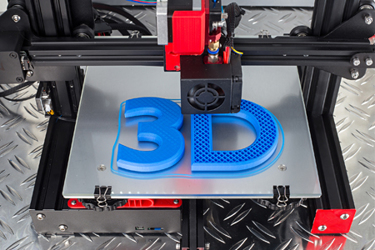Medical Device 3D Printing & Prototyping: Lessons Learned
By Matthew J. Allaway, DO, founder & CEO, Perineologic

Nearly a decade ago, I came up with the concept for a new medical device that could transform the way urologists, including myself, perform prostate biopsies. But as with many great ideas, there were several significant obstacles I needed to overcome before turning this concept into reality and many challenges to face during the journey of developing a new medical device and diagnostic procedure.
My education and professional background are in medicine and urology, including prostate cancer specifically. I did not have the formal experience in biomedical engineering that would allow me to design and develop a new medical device alone. There was also no predicate device that could serve as a useful reference or foundation for building a new device for improved prostate biopsy procedures. As is the case for most practicing clinicians, nearly every minute of my work week was dedicated to clinical responsibilities and patients, leaving little or no time for anything else, let alone planning for and producing this device. My challenge involved taking my concept and turning it into a device that could enable urologists to perform a prostate biopsy using this technique – referred to as a transperineal biopsy.
In the past, researchers, executives, and other professionals in the medical technology sector with a new idea would partner with a medical device engineering company to bring a concept to reality, often first by building an injection mold (injecting plastic materials molten by heat into a mold, and then cooling and solidifying them) with the desired characteristics. This process, even for a low production mold, could cost at least $30,000. It is also likely that the first mold would not be the final version and many iterations would need to be built before producing an ideal device, running up costs even more. As with many individuals or startups, I did not have the bandwidth for this endeavor. Also, in 2014, 3D printing was still a relatively challenging proposition – 3D printing patents were strictly enforced and purchasing a printer would be cost prohibitive. In addition, there are specific CAD software skills needed to design the files that feed a 3D printer to develop injection molds and a final product.
In my experience, there was no easy access to the technology or talent needed for 3D printing a new device for performing a transperineal biopsy. The nearest and best option I could find was a toy manufacturer using 3D printing technology. Although the manufacturer did not specialize in medical technology or devices, it had the core CAD design and printing capabilities that were required to develop the device. But as a tiny player in the market, let alone outside of their typical market, getting attention and timely production was challenging. To help expedite processes as much as possible, I provided the CAD engineer extremely detailed specifications of my hope for the end product design.
The Challenges Of 3D Printing
After transferring the work to a medical device design consultancy firm with expertise, more than a year and more than 12 iterations later, a final product began to surface. Throughout the process, one of the biggest challenges with 3D printing was that the resin used to print the device was different from the final substrate that would be used in the injection mold. The final product would include four types of material, each of which had characteristics that were necessary for their respective function. Although multiple resins can be used in 3D printing, communicating the different materials required to the team at the printing company, in addition to limited technology and 3D printing capabilities, turned out to be very complex. In one example, a nylon material was chosen for the adjustable clamping mechanism on the device. The clamp was designed to fit a variety of existing ultrasound probes of differing diameters. This feature would make it seamless for urologists to shift from a transrectal to a transperineal biopsy using their existing equipment. The soft, flexible nylon for the clamp is also lined with a soft, rubberized gasket material, which ensures that the clamp fits tightly and securely on any ultrasound probe. Unfortunately, the 3D printed parts used a resin that did not perform these various functions. It was also impossible to perform any validation or tolerance testing using the 3D printed components. In fact, there was no available 3D printed resin that would resemble the required materials of the final product.
We were not able to overcome these limitations and proceeded with conventional injection mold production and testing. However, despite the limitations at the time, the 3D printing technology still provided exceptional value. And currently there are more resins available that can be used to make components of the device, including ones that can be sterilized and implanted into patients safely.
Once a final design is agreed upon from 3D printed parts and adapted into an injection mold, engineering testing must be done. Due to the classification of this device, prior to any regulatory filing in either the U.S. or European Union, the design had to go through a battery of testing to ensure the design outputs (device performance, usability, etc.) met the design inputs; this is commonly referred to as design verification and validation. Given that the 3D printed materials of our new device could not be validated with these essential tests, we collaborated closely with the FDA throughout the early stages of development, including in clinical trials, to ensure it had sufficient oversight and could provide guidance regarding additional testing that might be needed and the order of testing. It was important to maintain transparency throughout the entire design and clinical trial processes and get the FDA’s valuable insights to ensure that we ultimately had a safe, effective, and validated product to bring to patients.
After a lengthy and complex design and development process, from concept to creation, it is very exciting that the final device and surgical technique, named the PrecisionPoint Transperineal Access System, achieved FDA clearance and is being actively used in the U.S. and around the globe in 13 other countries. It is quickly becoming the new standard for prostate biopsies. Now that many patents for 3D printing technology have expired, purchasing printers is affordable and practical for many individuals, researchers, and startup companies. My advice to inventors and innovators is to embrace 3D printing and capitalize on advancements in resin technology to validate a concept. It will also be important to fine-tune designs before committing to making injection molds once innovators reach this stage in the design process. Despite its challenges, 3D printing is a must for medical device innovators to bring their concepts to life and will continue to be essential in the years ahead.
About The Author:
 Matthew J. Allaway, DO, is the founder and president of Perineologic. Many of the company’s philosophies and attitudes regarding patient care resulted from Allaway’s own personal battle with cancer, including his decision to become a urologist. He has been a practicing urologist and managing partner at Urology Associates in Cumberland, MD, for about 20 years, with a focus on prostate cancer and female urology. He completed his residencies in urology and surgery as well as his internship at West Virginia University. Allaway earned his doctorate degree from Midwestern University and his Bachelor of Science degree from Illinois Benedictine College.
Matthew J. Allaway, DO, is the founder and president of Perineologic. Many of the company’s philosophies and attitudes regarding patient care resulted from Allaway’s own personal battle with cancer, including his decision to become a urologist. He has been a practicing urologist and managing partner at Urology Associates in Cumberland, MD, for about 20 years, with a focus on prostate cancer and female urology. He completed his residencies in urology and surgery as well as his internship at West Virginia University. Allaway earned his doctorate degree from Midwestern University and his Bachelor of Science degree from Illinois Benedictine College.
